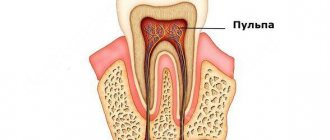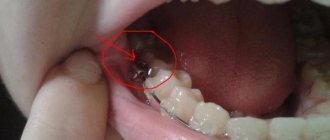Content:
- Why does it occur
- Signs
- How it proceeds
- Features of the development of periostitis in children and adults
- What happens if you don't undergo therapy?
- How to remove flux
- How to speed up recovery
- Preventive actions
An inflammatory dental disease that affects the periosteum tissue is called periostitis by dentists.
It is popularly known as flux. It is easy to recognize on your own - a painful abscess forms on the gum, which does not go away for a long time. It is unwise to fight this disease without medical help. When it appears, you should definitely make an appointment at a dental clinic and, during an in-person examination, find out from the doctor how to remove the flux without negative consequences for health.
It is simply impossible to ignore periostitis. It is usually accompanied by acute throbbing pain. Sometimes it can even lead to fever and a sharp decrease in performance. When there is a lot of pus in the “bag”, it bursts. Then the purulent masses flow out, and the symptoms cease to be so bright.
Who had the dream
The formation of an interpretation of dreams that corresponds to reality directly depends on who dreams a particular dream. The plot of the dream is of primary importance. Today there are many dream books, among which it is difficult to choose one that suggests the correct interpretation. Therefore, it is necessary to understand this issue in detail.
To a woman
For a married woman, dental gumboil predicts the appearance of a financially secure admirer in her life, who will try to gain attention to his person. If a young girl had a dream with the same plot, for her it will mean completing an urgent project at work.
To a man
Interpretation for a married man: flux may dream of making useful acquaintances. If a man is a bachelor, then for him this means well-deserved respect from his colleagues.
Pregnant
For a pregnant woman to acquire gumboil in a dream means that the expectant mother is experiencing strong feelings about the expected baby. To eliminate causes for concern, a woman in an interesting position should check her health with her doctor, and also try to avoid negative emotions and nervous stress.
Why does it occur
In order to understand how to remove flux, it is necessary to establish what led to its appearance. If the provoking factor is not eliminated, the disease may return. Among the main reasons for the violation:
- untreated deep caries;
- a large amount of hard plaque extending far under the gum;
- dental root cyst;
- inflammatory lesion of the gingival pocket;
- receiving mechanical injuries;
- general hypothermia of the body (especially against the background of reduced immunity);
- poor oral hygiene.
According to statistics, most often the disease occurs precisely because of advanced caries and pulpitis. If there is a large “hole,” the infection easily penetrates deep into the dental tissues, affects the surrounding structures and causes nerve destruction. Then pulpitis develops.
If left untreated, it will become chronic. The pain will become mild, but this does not mean that the disease has gone away. It’s just that now it’s happening secretly. The infection will continue to destroy the internal structures of the diseased unit. As they die, narcotic masses will begin to be released. To remove them, an abscess forms on the gum. This is flux.
If it is localized on the periosteum of the upper jaw, then the upper lip and the area under the eye swell. If inflammation progresses in the lower jaw, the chin and cheek swell, and the lymph nodes become painful.
Why is tooth flux dangerous?
An inflammatory process of this type tends to develop and, as it spreads, affects deeper layers of tissue. If left untreated, flux often develops into phlegmon - a serious purulent inflammation that has no definite boundaries. The most severe forms of flux provoke the development of sepsis, which can lead to infection of the entire body and even death. It is important not only to know how to cure gumboil and visit the dentist on time, but also to follow a number of preventive measures so that the likelihood of complications developing is minimal.
- Regular and high-quality hygiene.
- Treatment of caries at the initial stage. Flux, dental cysts and other complications often arise due to untreated pulpitis and periodontitis.
- Preventative visits to the clinic to assess the condition of the oral cavity and carry out professional cleaning.
Signs
You can understand that periostitis has developed by the following symptoms:
- tooth pain;
- swelling of the gums;
- an abscess at the base of the diseased unit;
- increased pain when pressing on the affected area;
- swelling of the cheek;
- increased body temperature;
- swelling of the lymph nodes.
If these symptoms occur, you should make an appointment with the dentist as soon as possible. In the early stages, the problem can be eliminated quite easily and quickly. Delay is fraught with health-threatening complications.
Symptoms
The clinical picture depends on factors such as the localization of inflammation and the causes of its occurrence, the body’s resistance, and the duration of the disease. Patients experience:
- redness of the mucous membrane;
- enlargement of the submandibular lymph nodes;
- deterioration of health;
- loss of appetite;
- weakness;
- temperature rise is possible.
Patients complain that not only the tooth hurts with gumboil: the painful sensations radiate to the ear, temple, and neck. In addition, swelling appears, due to which facial features lose their configuration. Depending on the location of the pain, the cheeks, upper or lower lip, chin, zygomatic and infraorbital areas swell from the flux. At the same time, the mobility of the jaw and lips is limited, and the patient has difficulty opening his mouth. The pain can be periodic: relief occurs when purulent exudate periodically pours into the oral cavity through the formed fistula.
In chronic periostitis, the symptoms are less pronounced. The pain is periodic, not severe, the contours of the face change slightly.
How it proceeds
The disease progresses through several successive stages:
- Acute serous. Spreads quickly. In just two or three days, a large, painful “bump” forms, with pus inside. The cheek tissues swell.
- Acute purulent. The pain becomes more pronounced, the person feels an unpleasant pulsation. The mucous membrane in the area of the affected unit turns red and swells. Body temperature rises.
- Acute diffuse. The swelling becomes voluminous. It can go under the eye or onto the nose. The patient's appearance changes significantly for the worse.
- Chronic. The painful process fades away and is replaced by a chronic one. The patient may mistakenly think that the problem has disappeared without a trace. In fact, it only calmed down for a while. Periodically, the disease will recur.
The sooner a sick person consults a doctor, the higher his chances of a speedy recovery.
What is flux and its types
Flux is an inflammatory process of the soft tissues of the periodontium and periosteum.
The scientific name of the disease is periostitis. It can occur on the gum under any tooth (or above it, if we are talking about the upper jaw). Caused by infection of dental tissues. The process of progression of periostitis goes through four stages (if you do not consult a dentist in a timely manner). The first is characterized by slight pain in the gums, “radiating” to the tooth. The second is the appearance of swelling and redness at the site of tissue infection (the tumor visually resembles a small sac). The third is an increase in body temperature, discharge of pus and swelling of the cheek due to inflammation. The fourth is manifested by severe throbbing pain and increased swelling. Types of flux:
- ordinary - the inflammatory process does not affect the periosteum;
- fibrous – inflammation spreads to the periosteum;
- orthodogenic – infection of bone tissue occurs (osteomyelitis);
- albuminous - a chronic form with a slight increase in temperature and periodic suppuration.
Features of the development of periostitis in children and adults
In adults, the disease usually has vivid symptoms. Most often it is caused by bad habits and ignoring the rules of oral hygiene. The tissues surrounding the root become inflamed. Persistent pain forces a person to seek dental care.
In children, flux usually progresses with mild symptoms. This is due to the fact that in children the immune system reacts less actively to abnormal processes in the oral cavity. Even if the purulent “bump” does not hurt the child, a consultation with a dentist is still required.
Diagnostics
Diagnosis of flux is carried out by a general examination of the diseased tooth. Since this disease does not have a similar picture to other dental diseases, the dentist has no doubt that the patient has gumboil. Of course, additional research is being conducted to establish a holistic picture of the disease itself:
- X-ray of a diseased tooth to see the depth and size of the abscess.
- A blood test to identify the pathogen and stage of the disease.
go to top
What happens if you don't undergo therapy?
It is unacceptable to treat purulent gum lesions as a minor dental disorder. It is very insidious and rarely disappears without a trace on its own. Often, if treatment is refused, the following occurs:
- Abscess. It is a consequence of a long-term presence of a pus-filled sac in the area of the tooth root. The abscess grows and then ruptures.
- Phlegmon. Represents an extended lesion. It usually occurs after a rupture of a purulent sac, if the patient does not comply with the dentist’s instructions, does not rinse the mouth with a special antiseptic solution, or apply anti-inflammatory gels.
- Osteomyelitis of the jaw. It occurs if the gums are not treated for a very long time. The pathological process spreads to the jaw bone, which is very dangerous.
- Inflammation of individual sinuses of the skull. It is also diagnosed with advanced periostitis. The maxillary, frontal and sphenoid sinuses are affected.
It is extremely rare that the disease affects brain tissue. Then the person may even die.
Who had gumboil in a dream?
Someone else has a similar problem with dental health - this means that in reality they are giving up good earnings in favor of a loved one.
You
If you yourself have developed dental flux, this can be interpreted as strengthening your own business reputation.
The child has
A child suffering from flux - from night visions wants to suggest that the one who is now sleeping is in danger of doing completely meaningless work.
With relatives
When you dream about a similar plot, it promises to receive a pleasant gift from a loved one.
With a spouse
If a flux appears in a dream for a husband or wife, it may mean that one of these days there will be a conflict situation with colleagues on work issues. According to the interpretation of the Islamic dream book, this is interpreted as a manifestation of some disease.
In a dream, you cannot meet your soulmate who has developed a flux - this means that in real life there is a lack of sincerity or trust in your relationship with your loved one.
At my brother's
A brother suffered from gumboil in a dream - this means that in real life you can prepare for the unexpected arrival of noisy guests.
At my sister's
A sister who gets flux in a dream signals emotional burnout of the person who saw this dream.
From a friend or girlfriend
When gumboil appears in one of your close friends’ dreams, it has a positive interpretation. This means that a person will experience career growth, that is, obtaining a higher-paying position in the near future. According to another dream interpreter, a dream prepares a person for hard and tedious work.
From a stranger
If you dream of a stranger who has such a health problem, this predicts stagnation in planned affairs. Everything that was planned for the coming week will stall and slow down. According to another meaning, such a dream promises the presentation of an expensive gift.
At the deceased's
If a deceased person suddenly develops swollen flux, this has a positive interpretation. It is worth waiting for pleasant acquisitions in reality.
How to remove flux
To avoid purulent damage to the pulp zone and periosteum, you need to receive qualified dental care in a timely manner. In the early stages of the disease, in order to prevent further progression of the inflammatory process, the patient is prescribed anti-inflammatory drugs and antibiotics. It is mandatory to open the abscess. The wound is then cleaned and washed with an antiseptic.
In some cases, to prevent re-accumulation of pus, drainage is installed for several days. All surgical procedures are always performed under general anesthesia so that the patient does not experience pain.
To support the patient’s body, he is additionally prescribed a vitamin and mineral complex. If necessary, physiotherapy is included in the treatment course. Good results can be obtained using UHF and electrophoresis.
It is important to strictly follow all medical recommendations and under no circumstances interrupt antibiotic therapy. Treatment is considered successfully completed if pus is no longer released, pain does not occur, and the entire wound has healed. In some cases, after healing, a small bluish scar remains on the gum. You shouldn't worry about it. This means that the defeat was very deep. Over time, the gums will return to their normal appearance.
Is a tooth removed during gumboil?
A tooth can be removed due to flux, but in modern dentistry the emphasis is on tooth-preserving manipulations. This also applies to flux. A tooth must be removed when its crown is seriously damaged and cannot be restored with a pin or inlays. If an infection occurs under the crown, then re-prosthetics are often difficult. In some cases, a tooth has to be removed because it is impossible to unfill the canals after a previous unsuccessful treatment, but this happens extremely rarely. In any case, the doctor makes the decision to remove a tooth based on the clinical picture.
How to speed up recovery
To make healing go faster, it is important not only to follow the dentist’s instructions, but also to remember the rules:
- do not heat the area where the pus was located;
- do not take antibiotics or any other medications unless prescribed by a doctor;
- do not use any folk recipes without consulting your doctor;
- Until the wound is completely healed, do not use aspirin or any medications that contain acetylsalicylic acid.
If the “bump” appears again, it is recommended to immediately contact a dental clinic.
Compresses and lotions
Compresses and lotions have an analgesic effect, limit the spread of the inflammatory process, and have a detrimental effect on pathogenic microorganisms.
Compresses with dimexide
Dimexide, when applied topically, perfectly penetrates into the inflammatory focus, inhibits the vital activity of microbes and increases their sensitivity to antibiotics. It is also able to eliminate pain. For a compress with flux, dimexide is diluted with warm water to a solution concentration of 20-30% (80 ml of liquid per 20 ml of the drug), after which a sterile napkin made of several layers of gauze is moistened with it. The compress is applied to the cheek in the affected area. The duration of the procedure is 1-2 hours. Repeat twice a day until pain and signs of inflammation are eliminated.
Before using Dimexide for the first time, it is necessary to test for an allergic reaction on the back of the elbow.
Lotions with soda
To treat gumboil, wrap a teaspoon of baking soda in several layers of gauze and place it between the cheek and gum for several hours. This will reduce swelling and relieve toothache. The lotion must be repeated 2-3 times a day.
Compress with salt
Salt has an anti-inflammatory effect, quickly relieves pain and reduces inflammation. To prepare a compress, dissolve 2-3 teaspoons of salt in 100 ml of warm water. A gauze or cotton swab is moistened with the solution and placed between the sore gum and cheek. Every 2 hours, change the compress to a new one until the acute symptoms subside.
It is better to use sea salt, which, due to the presence of iodine components, helps to relieve inflammation even better.
It is impossible to cure gumboil yourself without the participation of a dentist. Self-medication can be not only ineffective, but also dangerous. At home, you can only carry out those therapeutic procedures that have been recommended by a specialist.
Preventive actions
To reduce the likelihood of periostitis, you need to take care of your teeth and visit the dentist at least once a year. You can't start caries. As soon as a dark spot appears on the surface of the dental crown, it needs to be treated.
After eating, it is advisable to rinse your mouth with warm water. To make hygiene as high as possible, it makes sense to use not only a brush and toothpaste, but also dental floss and irrigators. It is very important to remove tartar every year at the dentist's office.
An important place in the issue of prevention is given to diet. You should eat as much fresh fruits, vegetables, and plant foods as possible. They require more thorough chewing and thus have a positive effect on the ligamentous apparatus that holds the tooth. They also provide natural cleansing of crowns from soft plaque.
If you have any questions about how to remove flux, please contact the doctors at the Line of Smile dental clinic for help. We specialize in the treatment of this disease and know how to quickly rid our patients of it.
What complications can flux cause?
The development of gumboil is a process in which treatment should not be delayed. If left unattended for a long time, flux can cause even more serious diseases that threaten not only the patient’s health, but also life.
Purulent flux can develop into such serious diseases as phlegmon, mediastenitis, osteomyelitis of the jaw and even sepsis. That is why, if a patient detects any first symptoms of flux development, he needs to immediately seek help.











